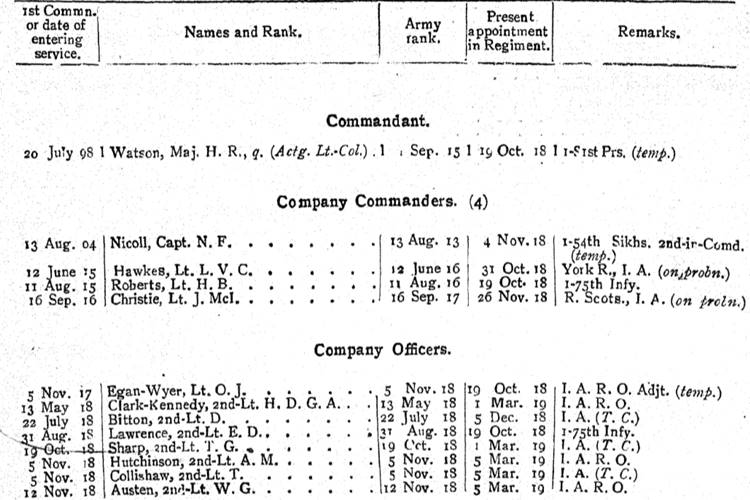This article on the 2nd Battalion 75th Carnatic Infantry aims to give you an overview of the Battalion’s activities during the First World War and help you research those who served with it. I have written a separate article on the 1st Battalion 75th Carnatic Infantry and guides to help you research a soldier who served in the Indian Army during the war. The links below will take you to my guides:
The 2nd Battalion 75th Carnatic Infantry in the First World War
Lineage: The 2nd Battalion 75th Carnatic Infantry was formed at Bangalore on 19 October 1918 and disbanded on 5 December 1920. For a history of the 75th Carnatic Infantry’s lineage see my page on the 1st Battalion 75th Carnatic Infantry.
Class Composition of Battalion in 1919: 2 Companies of Tamils, 1 Company of Madrasi Musalmans and 1 Company of Paraiyans and Christians.
The 2nd Battalion 75th Carnatic Infantry was a short-lived, war-raised Indian infantry battalion formed at Bangalore on 19 October 1918. The Battalion served as part of Southern Command, did not see active service and was disbanded on 5 December 1920.
Like the majority of Indian units raised in 1918, the Battalion has left few records to consult concerning its activities. The 2nd Battalion 75th Carnatic Infantry was commanded by Major (Acting-Lieutenant-Colonel) Henry Roswell Watson, who had been appointed from the 81st Pioneers where he had spent most of his career. Watson had been commissioned on 20 July 1898 and during the First World War had seen service against the Mohmands, a Pashtun tribe, in August 1915, the Marris in 1918 and subsequently in Persia between June and October 1918. The majority of British officers who served with the Battalion were either from the Indian Army Reserve of Officers (I.A.R.O.) or were on probation with the Indian Army. The Battalion was inspected by Brigadier-General Owen Cadogen Wolley Dod, C.B., D.S.O., Commanding Bangalore Brigade on 10 February 1919:
General Observations: Men are very well turned out and drill well and smartly. Up to the present very little has been done in the matter of Field Training. Men handle their arms well. System of instruction of officers is satisfactory. Individuality and independence of action are encouraged.
Interior economy is satisfactory. The Regiment is not yet fit for active service and contains too many men who have not fired the G. M. C. [General Musketry Course]. This is being taken in hand.
Very satisfactory progress has been made all round. Hardworking and capable lot of officers. All ranks have worked hard with good results.
Confidential review reports on Indian Army units, depots, British officers, etc. for 1918-1919: IOR/L/MIL/7/17030
The Battalion was disbanded on 20 December 1920. Below is an extract from the April 1919 Indian Army List recording the British officers who were then serving with the 2nd Battalion 75th Carnatic Infantry. Only two British officers were pre-war regulars with most of the officers either on probation or from the Indian Army Reserve of Officers (I.A.R.O.). There are usually a wide variety of records available for these officers and most will appear in the confidential report which I have quoted from above.
War Diaries of the 2nd Battalion 75th Carnatic Infantry
Unfortunately, there are no war diaries for the 2nd Battalion 75th Carnatic Infantry.
Further Sources of Information for the 2nd Battalion 75th Carnatic Infantry
If you’re researching a British of Indian officer who served with the Battalion, then the Indian Army List can be consulted. There is a single confidential report for the Battalion held at the British Library: Confidential review reports on Indian Army units, depots, British officers, etc. for 1918-1919: IOR/L/MIL/7/17030. This file also contains the confidential reports of the British officers who were serving with it at the time.

